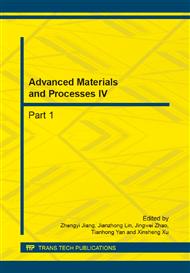[1]
Ma. X, Zhang. H and Ji. Y. Synthesis of ultrafine lanthanum hydroxide nanorods by a simple hydrothermal process. Mater. Lett, Vol. 58(2004), p.1180.
DOI: 10.1016/j.matlet.2003.08.031
Google Scholar
[2]
Neumann. A, Walter. D. The thermal transformation from lanthanum hydroxide to lanthanum hydroxide oxide. Thermochim. Acta Vol. 445(2006), p.200.
DOI: 10.1016/j.tca.2005.06.013
Google Scholar
[3]
Mekhemer. G, Balboul. B. Thermal genesis course and characterization of lanthanum oxide. Colloids Surf. A , Vol. 181(2001), p.19.
DOI: 10.1016/s0927-7757(00)00731-7
Google Scholar
[4]
Hou. B, Xu Y and Wu D. Synthesis and characteri-zation of ultralong lanthanum hydroxide nanorods via sol-vothermal method. J. Mater. Sci, Vol. 42(2007), p.1397.
DOI: 10.1007/s10853-006-0122-8
Google Scholar
[5]
Wang X, Li Y. Synthesis and characterization of lanthanide hydroxide single crystal nanowires. Angew. Chem. Int. Ed. Vol. 41(2002), p.4790.
DOI: 10.1002/anie.200290049
Google Scholar
[6]
Wang X, Wang M and Song H. A simple sol-gel technique for preparing lanthanum oxide nanopowders. Mater. Lett. Vol. 60(2006), p.2261.
DOI: 10.1016/j.matlet.2005.12.142
Google Scholar
[7]
Zhang H, Yang D and Ji Y. Low temperature synthesis of flowerlike ZnO nanostructures by cetyltrimethylammonium bromide assisted hydrothermal process. J. Phys. Chem. B. Vol. 108(2004), p.3955.
DOI: 10.1021/jp036826f
Google Scholar
[8]
Zhang N, Yi R and Zhou L. Lanthanide hydroxide nanorods and their thermal decomposition to lanthanide oxide nanorods. Mater. Chem. Phys. Vol. 114(2009), p.160.
DOI: 10.1016/j.matchemphys.2008.09.004
Google Scholar
[9]
Tang. B, Ge. J and Wu. C. Solvothermal synthesis and microwave evolution of La(OH)3 nanorods to La2O3 nanorods. Nano-technology. Vol. 15(2004), p.1273.
DOI: 10.1088/0957-4484/15/9/027
Google Scholar
[10]
Pan Z, Dai, Z and Wang Z . Lead oxide nanobelts and phase transformation induced by electron beam irradiation. Appl. Phys. Lett. Vol. 80(2002), p.309.
DOI: 10.1063/1.1432749
Google Scholar
[11]
Bouyer F, Sanson N and Destarac M. Hydrophilic block copolymerdirected growth of lanthanum hydroxide nanoparticles. New J. Chem. Vol. 30(2006), p.99.
DOI: 10.1039/b516368d
Google Scholar
[12]
Wang. H, Hu. Y and Zhang. L. Dispersion behavior of TiO2 nanoparticles synthesized by H2/O2 combustion flame. China powder sci and tech (in chin). Vol. 16(2010), p.43.
Google Scholar
[13]
Ren. Z, Hong. R. Study of synthesis and photocatalytic property of nano titania powder by H2/Air flame diffusion combustion. Rare Metals and Cemented Carbides(in Chin). Vol. 36(2008), p.23.
Google Scholar
[14]
Hu. Y, Cong D and Jiang H. Mechanism analysis and preparation of core shell TiO2/SiO2 nanoparticles by H2/Air flame combustions. Journal of Inorganic Materials (in Chin). Vol. 22(2007), p.205.
Google Scholar
[15]
Ding. H, Li. C. Preparation of nano Al2O3 particles via H2/air flame synthesis and their dispersion performance. Chinese Journal of Process Engineering (in Chin). Vol. 11(2011), p.137.
Google Scholar
[16]
Yin. S, Wu. W and Zhang. B. Study on separation technology of Pr and Nd in D2EHPA-HCl-LA coordination extraction system. Journal of Rare Earths Supplement. Vol. 28(2010), p.111.
DOI: 10.1016/s1002-0721(10)60327-4
Google Scholar
[17]
Wu W, Zhang F and Bian X. Effect of loaded organic phase containing mixtures of silicon and aluminum, single iron on extraction of lanthanum in saponifica-tion P507-HCl system. Journal of Rare Earths. Vol. 31(2013), p.722.
DOI: 10.1016/s1002-0721(12)60348-2
Google Scholar
[18]
Wu W, Li D and Zhao Z. Formation mechanism of micro emulsion on aluminum and lantha-num extraction in P507-HCl system. Journal of Rare Earths. Vol. 28(2010), p.174.
DOI: 10.1016/s1002-0721(10)60314-6
Google Scholar
[19]
Yin S, Wu W and Bian X. Effect of complexing agent lactic acid on the extraction and separation of Pr(III)/Ce(III) with di(2-ethylhexyl) phosphoric acid. Hydrometallurgy. Vol. 131–132(2013), p.133.
DOI: 10.1016/j.hydromet.2012.11.005
Google Scholar
[20]
Yin S, Wu W and Bian X. Solvent extraction of La (III) from chloride medium in the presence of two water soluble complexing agents with di(2ethylhexyl) phosphoric acid. Industrial & Engineering Chemistry Research, (2013).
DOI: 10.1021/ie400403w
Google Scholar
[21]
J Carvajal, Marsal. P and Salagre. M. Effect of the La(OH)3 preparation method on the surface and rehy-droxylation properties of resulting La2O3 nanoparticles . J Nanopart Res. Vol. 15(2013), p.1479.
DOI: 10.1007/s11051-013-1479-7
Google Scholar
[22]
Peter. F, Richard A and Justin D. The Rapid formation of La(OH)3 from La2O3 powders on exposure to water vapor. J. Am. Ceram. Soc. Vol. 93(2010), p.1187.
Google Scholar


